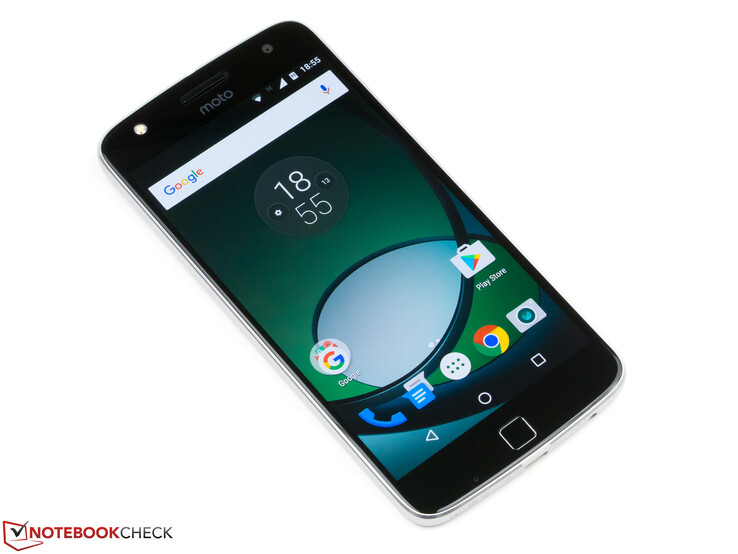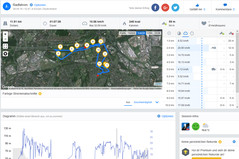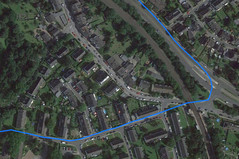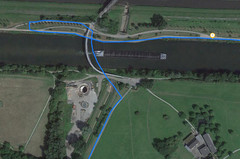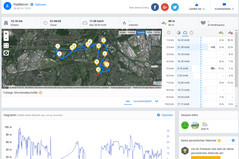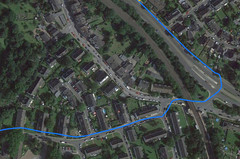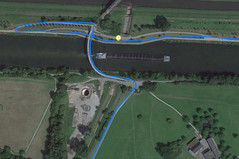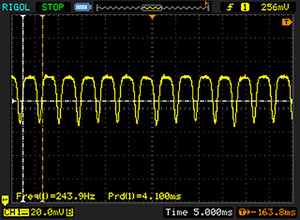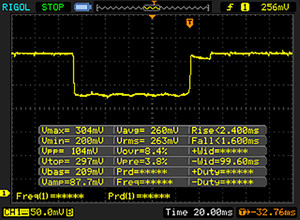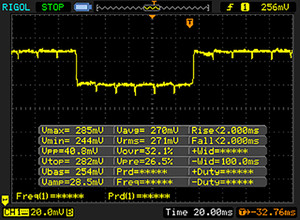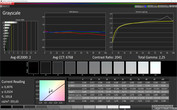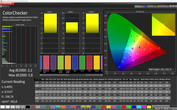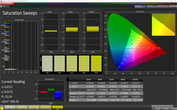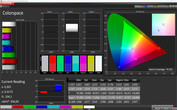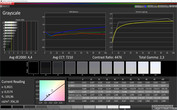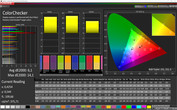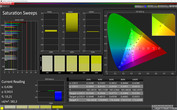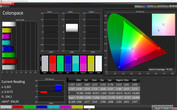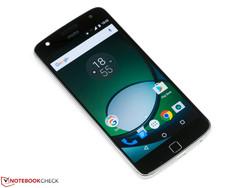Breve análisis del Smartphone Lenovo Moto Z Play
Top 10 Análisis
» Top 10 Portátiles Multimedia
» Top 10 Portátiles de Juego
» Top 10 Portátiles de Juego ligeros
» Top 10 Portátiles Asequibles de Oficina/Empresa
» Top 10 Portátiles de Juego Ligeros
» Top 10 Portátiles de Oficina/Empresa Premium
» Top 10 Estaciones de Trabajo
» Top 10 Subportátiles
» Top 10 Ultrabooks
» Top 10 Convertibles
» Top 10 Tablets
» Top 10 Tablets Windows
» Top 10 Tablets de menos de 250 Euros
» Top 10 Phablets (>5.5")
» Top 10 Smartphones
» Top 10 Smartphones (≤5")
» Top 10 Smartphones de menos de 300 Euros
» Top 10 Smartphones de menos de 120 Euros
» Top 10 Portátiles de menos de 1000 Euros
» Top 10 Portátiles de menos de 500 Euros
» Top 10 Portátiles de menos de 300 Euros
» Los Mejores Displays de Portátiles Analizados por Notebookcheck
| Networking | |
| iperf3 transmit AX12 | |
| Apple iPhone 7 (Klaus I211) | |
| OnePlus 3 | |
| Huawei P9 | |
| Lenovo Moto Z Play | |
| Motorola Moto X Play | |
| Asus Zenfone 3 ZE552KL | |
| iperf3 receive AX12 | |
| Apple iPhone 7 (Klaus I211) | |
| OnePlus 3 | |
| Huawei P9 | |
| Lenovo Moto Z Play | |
| Motorola Moto X Play | |
| Asus Zenfone 3 ZE552KL | |
| |||||||||||||||||||||||||
iluminación: 93 %
Brillo con batería: 509 cd/m²
Contraste: ∞:1 (Negro: 0 cd/m²)
ΔE ColorChecker Calman: 2.2 | ∀{0.5-29.43 Ø4.78}
ΔE Greyscale Calman: 2 | ∀{0.09-98 Ø5}
Gamma: 2.25
CCT: 6768 K
| Lenovo Moto Z Play AMOLED, 1920x1080, 5.5" | Samsung Galaxy A5 2016 Super AMOLED, 1920x1080, 5.2" | Sony Xperia XA IPS, 1280x720, 5" | Huawei P9 Lite IPS, 1920x1080, 5.2" | Honor 8 IPS, 1920x1080, 5.2" | OnePlus 3 Optic-AMOLED, 1920x1080, 5.5" | Lenovo Moto Z AMOLED, 2560x1440, 5.5" | |
|---|---|---|---|---|---|---|---|
| Screen | |||||||
| Brightness middle (cd/m²) | 509 | 378 -26% | 518 2% | 505 -1% | 451 -11% | 419 -18% | 485 -5% |
| Brightness (cd/m²) | 511 | 380 -26% | 475 -7% | 468 -8% | 443 -13% | 431 -16% | 490 -4% |
| Brightness Distribution (%) | 93 | 91 -2% | 81 -13% | 88 -5% | 93 0% | 84 -10% | 92 -1% |
| Black Level * (cd/m²) | 0.61 | 0.74 | 0.4 | ||||
| Colorchecker dE 2000 * | 2.2 | 1.95 11% | 6.8 -209% | 4.1 -86% | 5.4 -145% | 4.1 -86% | 2.1 5% |
| Colorchecker dE 2000 max. * | 5.8 | 3.09 47% | 11.4 -97% | 5.8 -0% | 9.9 -71% | 12 -107% | 5.5 5% |
| Greyscale dE 2000 * | 2 | 1.86 7% | 7 -250% | 4.9 -145% | 6.7 -235% | 3.3 -65% | 2.6 -30% |
| Gamma | 2.25 98% | 2.13 103% | 2.35 94% | 2.5 88% | 2.33 94% | 2.1 105% | 2.23 99% |
| CCT | 6768 96% | 6376 102% | 8151 80% | 7116 91% | 8262 79% | 6550 99% | 6843 95% |
| Contrast (:1) | 849 | 682 | 1128 | ||||
| Color Space (Percent of AdobeRGB 1998) (%) | 89.38 | 88.14 | |||||
| Color Space (Percent of sRGB) (%) | 100 | 100 |
* ... más pequeño es mejor
Parpadeo de Pantalla / PWM (Pulse-Width Modulation)
| Parpadeo de Pantalla / PWM detectado | 243.9 Hz | ||
La retroiluminación del display parpadea a 243.9 Hz (seguramente usa PWM - Pulse-Width Modulation) . La frecuencia de 243.9 Hz es relativamente baja, por lo que la gente sensible debería ver parpadeos y padecer fatiga visual por la pantalla (usado al brillo indicado a continuación). Comparación: 53 % de todos los dispositivos testados no usaron PWM para atenuar el display. Si se usó, medimos una media de 8111 (mínimo: 5 - máxmo: 343500) Hz. | |||
Tiempos de respuesta del display
| ↔ Tiempo de respuesta de Negro a Blanco | ||
|---|---|---|
| 4 ms ... subida ↗ y bajada ↘ combinada | ↗ 2.4 ms subida | |
| ↘ 1.6 ms bajada | ||
| La pantalla mostró tiempos de respuesta muy rápidos en nuestros tests y debería ser adecuada para juegos frenéticos. En comparación, todos los dispositivos de prueba van de ##min### (mínimo) a 240 (máximo) ms. » 15 % de todos los dispositivos son mejores. Esto quiere decir que el tiempo de respuesta medido es mejor que la media (20.2 ms) de todos los dispositivos testados. | ||
| ↔ Tiempo de respuesta 50% Gris a 80% Gris | ||
| 4 ms ... subida ↗ y bajada ↘ combinada | ↗ 2 ms subida | |
| ↘ 2 ms bajada | ||
| La pantalla mostró tiempos de respuesta muy rápidos en nuestros tests y debería ser adecuada para juegos frenéticos. En comparación, todos los dispositivos de prueba van de ##min### (mínimo) a 636 (máximo) ms. » 14 % de todos los dispositivos son mejores. Esto quiere decir que el tiempo de respuesta medido es mejor que la media (31.6 ms) de todos los dispositivos testados. | ||
| AnTuTu v6 - Total Score (ordenar por valor) | |
| Lenovo Moto Z Play | |
| Samsung Galaxy A5 2016 | |
| Sony Xperia XA | |
| Huawei P9 Lite | |
| Honor 8 | |
| OnePlus 3 | |
| Lenovo Moto Z | |
| Geekbench 3 | |
| 32 Bit Multi-Core Score (ordenar por valor) | |
| Lenovo Moto Z Play | |
| Samsung Galaxy A5 2016 | |
| 32 Bit Single-Core Score (ordenar por valor) | |
| Lenovo Moto Z Play | |
| Samsung Galaxy A5 2016 | |
| 64 Bit Multi-Core Score (ordenar por valor) | |
| Huawei P9 Lite | |
| OnePlus 3 | |
| Lenovo Moto Z | |
| 64 Bit Single-Core Score (ordenar por valor) | |
| Huawei P9 Lite | |
| OnePlus 3 | |
| Lenovo Moto Z | |
| Geekbench 4.0 | |
| 64 Bit Multi-Core Score (ordenar por valor) | |
| Lenovo Moto Z Play | |
| Honor 8 | |
| OnePlus 3 | |
| Lenovo Moto Z | |
| 64 Bit Single-Core Score (ordenar por valor) | |
| Lenovo Moto Z Play | |
| Honor 8 | |
| OnePlus 3 | |
| Lenovo Moto Z | |
| Compute RenderScript Score (ordenar por valor) | |
| Lenovo Moto Z Play | |
| Honor 8 | |
| OnePlus 3 | |
| Lenovo Moto Z | |
| PCMark for Android - Work performance score (ordenar por valor) | |
| Lenovo Moto Z Play | |
| Samsung Galaxy A5 2016 | |
| Sony Xperia XA | |
| Huawei P9 Lite | |
| Honor 8 | |
| OnePlus 3 | |
| Lenovo Moto Z | |
| GFXBench (DX / GLBenchmark) 2.7 | |
| T-Rex Onscreen (ordenar por valor) | |
| Lenovo Moto Z Play | |
| Samsung Galaxy A5 2016 | |
| Sony Xperia XA | |
| Huawei P9 Lite | |
| Honor 8 | |
| OnePlus 3 | |
| Lenovo Moto Z | |
| 1920x1080 T-Rex Offscreen (ordenar por valor) | |
| Lenovo Moto Z Play | |
| Samsung Galaxy A5 2016 | |
| Sony Xperia XA | |
| Huawei P9 Lite | |
| Honor 8 | |
| OnePlus 3 | |
| Lenovo Moto Z | |
| GFXBench 3.0 | |
| 1920x1080 1080p Manhattan Offscreen (ordenar por valor) | |
| Lenovo Moto Z Play | |
| Samsung Galaxy A5 2016 | |
| Sony Xperia XA | |
| Huawei P9 Lite | |
| Honor 8 | |
| OnePlus 3 | |
| Lenovo Moto Z | |
| on screen Manhattan Onscreen OGL (ordenar por valor) | |
| Lenovo Moto Z Play | |
| Samsung Galaxy A5 2016 | |
| Sony Xperia XA | |
| Huawei P9 Lite | |
| Honor 8 | |
| OnePlus 3 | |
| Lenovo Moto Z | |
| GFXBench 3.1 | |
| 1920x1080 Manhattan ES 3.1 Offscreen (ordenar por valor) | |
| Lenovo Moto Z Play | |
| Sony Xperia XA | |
| Huawei P9 Lite | |
| Honor 8 | |
| OnePlus 3 | |
| Lenovo Moto Z | |
| on screen Manhattan ES 3.1 Onscreen (ordenar por valor) | |
| Lenovo Moto Z Play | |
| Sony Xperia XA | |
| Huawei P9 Lite | |
| Honor 8 | |
| OnePlus 3 | |
| Lenovo Moto Z | |
| 3DMark | |
| 1280x720 offscreen Ice Storm Unlimited Score (ordenar por valor) | |
| Lenovo Moto Z Play | |
| Samsung Galaxy A5 2016 | |
| Sony Xperia XA | |
| Huawei P9 Lite | |
| Honor 8 | |
| OnePlus 3 | |
| Lenovo Moto Z | |
| 1280x720 offscreen Ice Storm Unlimited Graphics Score (ordenar por valor) | |
| Lenovo Moto Z Play | |
| Samsung Galaxy A5 2016 | |
| Sony Xperia XA | |
| Huawei P9 Lite | |
| Honor 8 | |
| OnePlus 3 | |
| Lenovo Moto Z | |
| 1280x720 offscreen Ice Storm Unlimited Physics (ordenar por valor) | |
| Lenovo Moto Z Play | |
| Samsung Galaxy A5 2016 | |
| Sony Xperia XA | |
| Huawei P9 Lite | |
| Honor 8 | |
| OnePlus 3 | |
| Lenovo Moto Z | |
| 2560x1440 Sling Shot OpenGL ES 3.0 Physics (ordenar por valor) | |
| Lenovo Moto Z Play | |
| Samsung Galaxy A5 2016 | |
| Sony Xperia XA | |
| Huawei P9 Lite | |
| Honor 8 | |
| OnePlus 3 | |
| Lenovo Moto Z | |
| 2560x1440 Sling Shot OpenGL ES 3.0 Graphics (ordenar por valor) | |
| Lenovo Moto Z Play | |
| Samsung Galaxy A5 2016 | |
| Sony Xperia XA | |
| Huawei P9 Lite | |
| Honor 8 | |
| OnePlus 3 | |
| Lenovo Moto Z | |
| 2560x1440 Sling Shot OpenGL ES 3.0 (ordenar por valor) | |
| Lenovo Moto Z Play | |
| Samsung Galaxy A5 2016 | |
| Sony Xperia XA | |
| Huawei P9 Lite | |
| Honor 8 | |
| OnePlus 3 | |
| Lenovo Moto Z | |
| Mozilla Kraken 1.1 - Total (ordenar por valor) | |
| Lenovo Moto Z Play | |
| Samsung Galaxy A5 2016 | |
| Sony Xperia XA | |
| Huawei P9 Lite | |
| Honor 8 | |
| OnePlus 3 | |
| Lenovo Moto Z | |
| Octane V2 - Total Score (ordenar por valor) | |
| Lenovo Moto Z Play | |
| Samsung Galaxy A5 2016 | |
| Sony Xperia XA | |
| Huawei P9 Lite | |
| Honor 8 | |
| OnePlus 3 | |
| Lenovo Moto Z | |
| WebXPRT 2015 - Overall (ordenar por valor) | |
| Lenovo Moto Z Play | |
| Samsung Galaxy A5 2016 | |
| Sony Xperia XA | |
| Huawei P9 Lite | |
| Honor 8 | |
| OnePlus 3 | |
| Lenovo Moto Z | |
| JetStream 1.1 - Total Score (ordenar por valor) | |
| Lenovo Moto Z Play | |
| Samsung Galaxy A5 2016 | |
| Sony Xperia XA | |
| Huawei P9 Lite | |
| Honor 8 | |
| OnePlus 3 | |
| Lenovo Moto Z | |
* ... más pequeño es mejor
| Lenovo Moto Z Play | Samsung Galaxy A5 2016 | Sony Xperia XA | Huawei P9 Lite | Honor 8 | OnePlus 3 | Lenovo Moto Z | |
|---|---|---|---|---|---|---|---|
| AndroBench 3-5 | -38% | -22% | -27% | -11% | 91% | 77% | |
| Random Read 4KB (MB/s) | 38.78 | 22.9 -41% | 22.05 -43% | 38.22 -1% | 34.16 -12% | 137.6 255% | 117.2 202% |
| Random Write 4KB (MB/s) | 45.58 | 11.2 -75% | 10.6 -77% | 15.35 -66% | 31.5 -31% | 18.23 -60% | 74.9 64% |
| Sequential Write 256KB (MB/s) | 73.1 | 60.4 -17% | 68.6 -6% | 46.24 -37% | 119.3 63% | 153.3 110% | 168.3 130% |
| Sequential Read 256KB (MB/s) | 254.8 | 209.4 -18% | 240.4 -6% | 283.5 11% | 247.5 -3% | 408.7 60% | 439.7 73% |
| Sequential Write 256KB SDCard (MB/s) | 50.6 | 50.7 0% | 25.1 -50% | 23.59 -53% | 45.64 -10% | ||
| Sequential Read 256KB SDCard (MB/s) | 74.6 | 72.9 -2% | 60.8 -18% | 53.7 -28% | 78.5 5% |
| Asphalt 8: Airborne | |||
| Configuraciones | Valor | ||
| high | 30 fps | ||
| very low | 30 fps | ||
| Dead Trigger 2 | |||
| Configuraciones | Valor | ||
| high | 56 fps | ||
(+) La temperatura máxima en la parte superior es de 34.5 °C / 94 F, frente a la media de 35.2 °C / 95 F, que oscila entre 21.9 y 247 °C para la clase Smartphone.
(+) El fondo se calienta hasta un máximo de 32.7 °C / 91 F, frente a la media de 34 °C / 93 F
(+) En reposo, la temperatura media de la parte superior es de 28.5 °C / 83# F, frente a la media del dispositivo de 32.9 °C / 91 F.
Lenovo Moto Z Play análisis de audio
(+) | los altavoces pueden reproducir a un volumen relativamente alto (#88.1 dB)
Graves 100 - 315 Hz
(-) | casi sin bajos - de media 28.9% inferior a la mediana
(±) | la linealidad de los graves es media (8.3% delta a frecuencia anterior)
Medios 400 - 2000 Hz
(±) | medios reducidos - de media 5.2% inferior a la mediana
(+) | los medios son lineales (4.7% delta a la frecuencia anterior)
Altos 2 - 16 kHz
(+) | máximos equilibrados - a sólo 1.9% de la mediana
(+) | los máximos son lineales (1.4% delta a la frecuencia anterior)
Total 100 - 16.000 Hz
(±) | la linealidad del sonido global es media (17.9% de diferencia con la mediana)
En comparación con la misma clase
» 15% de todos los dispositivos probados de esta clase eran mejores, 8% similares, 77% peores
» El mejor tuvo un delta de 11%, la media fue 35%, el peor fue ###max##%
En comparación con todos los dispositivos probados
» 36% de todos los dispositivos probados eran mejores, 8% similares, 56% peores
» El mejor tuvo un delta de 4%, la media fue 24%, el peor fue ###max##%
no name análisis de audio
(+) | los altavoces pueden reproducir a un volumen relativamente alto (#95.2 dB)
Graves 100 - 315 Hz
(±) | lubina reducida - en promedio 11.6% inferior a la mediana
(±) | la linealidad de los graves es media (7.4% delta a frecuencia anterior)
Medios 400 - 2000 Hz
(+) | medios equilibrados - a sólo 2.7% de la mediana
(+) | los medios son lineales (2.6% delta a la frecuencia anterior)
Altos 2 - 16 kHz
(+) | máximos equilibrados - a sólo 2.4% de la mediana
(+) | los máximos son lineales (3.8% delta a la frecuencia anterior)
Total 100 - 16.000 Hz
(+) | el sonido global es lineal (10.5% de diferencia con la mediana)
En comparación con la misma clase
» 5% de todos los dispositivos probados de esta clase eran mejores, 1% similares, 94% peores
» El mejor tuvo un delta de 4%, la media fue 24%, el peor fue ###max##%
En comparación con todos los dispositivos probados
» 5% de todos los dispositivos probados eran mejores, 1% similares, 94% peores
» El mejor tuvo un delta de 4%, la media fue 24%, el peor fue ###max##%
Lenovo Moto Z análisis de audio
(+) | los altavoces pueden reproducir a un volumen relativamente alto (#83.9 dB)
Graves 100 - 315 Hz
(-) | casi sin bajos - de media 34.4% inferior a la mediana
(±) | la linealidad de los graves es media (8.2% delta a frecuencia anterior)
Medios 400 - 2000 Hz
(±) | medios reducidos - de media 5.4% inferior a la mediana
(+) | los medios son lineales (6% delta a la frecuencia anterior)
Altos 2 - 16 kHz
(+) | máximos equilibrados - a sólo 2.3% de la mediana
(+) | los máximos son lineales (1.8% delta a la frecuencia anterior)
Total 100 - 16.000 Hz
(±) | la linealidad del sonido global es media (23.5% de diferencia con la mediana)
En comparación con la misma clase
» 53% de todos los dispositivos probados de esta clase eran mejores, 8% similares, 39% peores
» El mejor tuvo un delta de 11%, la media fue 35%, el peor fue ###max##%
En comparación con todos los dispositivos probados
» 69% de todos los dispositivos probados eran mejores, 6% similares, 24% peores
» El mejor tuvo un delta de 4%, la media fue 24%, el peor fue ###max##%
| Off / Standby | |
| Ocioso | |
| Carga |
|
Clave:
min: | |
| Lenovo Moto Z Play 3510 mAh | Samsung Galaxy A5 2016 2900 mAh | Sony Xperia XA 2300 mAh | Huawei P9 Lite 3000 mAh | Honor 8 3000 mAh | OnePlus 3 3000 mAh | Lenovo Moto Z 2600 mAh | |
|---|---|---|---|---|---|---|---|
| Power Consumption | -74% | -69% | -98% | -108% | -104% | -62% | |
| Idle Minimum * (Watt) | 0.51 | 0.96 -88% | 0.72 -41% | 0.73 -43% | 0.78 -53% | 0.57 -12% | 0.66 -29% |
| Idle Average * (Watt) | 0.87 | 1.64 -89% | 1.5 -72% | 2.09 -140% | 1.89 -117% | 1.24 -43% | 1.01 -16% |
| Idle Maximum * (Watt) | 0.9 | 1.71 -90% | 1.57 -74% | 2.11 -134% | 2.02 -124% | 1.36 -51% | 1.09 -21% |
| Load Average * (Watt) | 1.69 | 2.98 -76% | 3.48 -106% | 4.15 -146% | 5.28 -212% | 5.92 -250% | 3.97 -135% |
| Load Maximum * (Watt) | 4 | 5.08 -27% | 6.04 -51% | 5.05 -26% | 5.44 -36% | 10.53 -163% | 8.34 -109% |
* ... más pequeño es mejor
| Lenovo Moto Z Play 3510 mAh | Samsung Galaxy A5 2016 2900 mAh | Sony Xperia XA 2300 mAh | Huawei P9 Lite 3000 mAh | Honor 8 3000 mAh | OnePlus 3 3000 mAh | Lenovo Moto Z 2600 mAh | |
|---|---|---|---|---|---|---|---|
| Duración de Batería | -26% | -66% | -46% | -49% | -33% | -47% | |
| Reader / Idle (h) | 42.3 | 38.7 -9% | 12.9 -70% | 23.4 -45% | 24.8 -41% | 22.3 -47% | 22.9 -46% |
| H.264 (h) | 19.8 | 11.2 -43% | 7.7 -61% | 9.5 -52% | 8.8 -56% | 14.1 -29% | 12.1 -39% |
| WiFi v1.3 (h) | 13.7 | 10.4 -24% | 5.9 -57% | 10.1 -26% | 8.3 -39% | 14 2% | 6.8 -50% |
| Load (h) | 10.9 | 8.1 -26% | 2.8 -74% | 4.5 -59% | 4.3 -61% | 4.5 -59% | 5.3 -51% |
Pro
Contra
Como con el Moto Z, una de las principales características del Moto Z Play es su ampliabilidad por Moto Mods. Según Lenovo, estos módulos tendrán soporte al menos durante tres generaciones de dispositivos. Sin embargo, los compradores tendrán que rascarse bien los bolsillos primero. Aún si cabe pensar que esto no tiene sentido, al mirar el Moto Z Play se recomienda: Con su SoC Snapdragon 625 eficiente pero bastante rápido, logra un aguante de batería muy grande, la pantalla convence con alto contraste y buena estabilidad de ángulo de visión, y la carcasa de compuesto metal-vidrio parece de primera. Lo que es más, el modelo de pruebas ofrece casi todo lo que los compradores de smartphone desean con funcionalidad dual-SIM, NFC, USB Type-C, y veloz lector de huellas - incluso integra una clavija 3.5-mm. Uno de los pocos defectos del modelo de pruebas es el poco fiable autofocus de la cámara principal.
A la vista de la gran diferencia de precio de más de 200 Euros entre el Moto Z y el Moto Z Play, los defectos menores del modelo más barato en algunos aspectos son sorprendentes. Los compradores que puedan pasar sin esa última pizca de nitidez de pantalla, un diseño extremadamente delgado, y mucha reserva de potencia a cambio del doble de aguante de batería irán bien aconsejados con el Moto Z Play.
Una alternativa interesante basada en un SoC Snapdragon 625 seria el Asus ZenFone 3. La construcción del dispositivo es de primera y trae un amplio paquete software de fábrica. SIn embargo, a diferencia del Moto Z Play, no trae NFC ni ampliabilidad modular. Los compradores que quieran potencia de gama alta a precios de gama media querrán leer nuestro próximo análisis del ZTE Axon 7.
Ésta es una versión acortada del análisis original. Puedes leer el análisis completo en inglés aquí.
Lenovo Moto Z Play
- 10/27/2016 v5.1 (old)
Andreas Kilian




